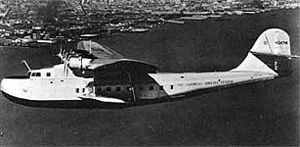- Martin M-130
-
M-130 Role flying boat Manufacturer Glenn L. Martin Company First flight December 30, 1934 Status retired Primary user Pan American Airways Number built 3 The Martin M-130 was a commercial flying boat designed and built in 1935 by the Glenn L. Martin Company in Baltimore, Maryland, for Pan American Airways. Only three M-130s were built: the China Clipper, the Philippine Clipper and the Hawaii Clipper. A fourth flying boat (designated as M-156) called the Russian Clipper was built for the Soviet Union which was essentially identical to the three Pan Am models except that it had a larger wing (giving it a longer range) and twin vertical stabilizers.
Martin designated them as the Martin Ocean Transports, but to the public they were all referred to as the China Clipper, a name which evolved into a generic term for Pan Am's entire fleet of large flying boats - the Martin M-130, Sikorsky S-42, and Boeing 314.[1]
Contents
Operational history
Designed to meet Pan American Airways President Juan Trippe's desire for a trans-Pacific aircraft,[2] the M-130 was an all-metal flying boat which employed streamlined aerodynamics and powerful engines, selling at US$417,000 a copy, to achieve Pan Am's specifications for range and payload. The M-130's first flight was on December 30, 1934.[3] On November 22, 1935, the China Clipper, piloted by Captain Edwin C. Musick and First Officer R.O.D. Sullivan flew the first trans-Pacific airmail route.[1] As illustrated on this page, a postage stamp, Scott Catalog C-20, was printed for use on the transpacific service. With extended service two more denominations were later issued. All three have the same design showing the M-130 in flight.
The Philippine Clipper inaugurated passenger service between the United States and Hong Kong on October 14, 1936. while later the same month, the Hawaii Clipper inaugurated scheduled trans-Pacific passenger service between California and the Philippines. The flight departed the United States on October 21, 1936, and the round trip to and from Manila required two weeks to complete.[1]
In July 1938, the Hawaii Clipper disappeared over the Pacific on a flight between Guam and Manila with the loss of nine crew and six passengers. No cause for the loss was determined.[4]
Their range and capacity made them prime candidates to fulfill the over ocean hauling needs of the military during World War II. Beginning in 1942, the two remaining planes were pressed into transport roles for the United States Navy. The Philippine Clipper which survived the Japanese attack on Wake Island following the attack on Pearl Harbor[5] crashed in January 1943 when it hit the side of a mountain as it descended to land in San Francisco. ComSubPac Admiral Robert H. English was killed, along with 18 others. [6]
The final M-130, the China Clipper, broke up and sank during landing at Port of Spain, Trinidad and Tobago on January 8, 1945 killing 23 of those onboard [7]
Specifications (Martin M-130)
Data from[citation needed]
General characteristics
- Crew: 6-9 (Captain, First Officer, Junior Flight Officer, Engineering Officer, Assistant Engineering Officer, Radio Operator, Navigation Officer, plus cabin stewards)
- Capacity: 36 day, 18 night passengers
- Length: 90 ft 10 ½ in (27.7 m)
- Wingspan: 130 ft (39.7 m)
- Height: 24 ft 7 in (7.5 m)
- Max takeoff weight: 52,252 lb (23,701 kg)
- Powerplant: 4 × Pratt & Whitney R-1830-S2A5G Twin Wasp 14-cylinder radial engines, 830 hp (708 kW) later 950 hp with hydromatic propellers each
Performance
- Maximum speed: 180 mph (290 km/h)
- Cruise speed: 130 mph (209 km/h)
- Range: 3,200 mi (5,150 km)
- Service ceiling: 10,000 ft (3,048 m)
See also
- Related development
- Related lists
- List of seaplanes and amphibious aircraft
Notes
- ^ a b c Flying Clippers undated, URL retrieved 19 August 2007
- ^ Chasing the Sun at PBS.com undated, URL retrieved on 20 August 2007
- ^ The Golden Age of Aviation undated, URL retrieved on 20 August 2007.
- ^ Aviation Safety Network 10 October 2006, URL retrieved 19 August 2007
- ^ Flying Clippers at War undated, URL retrieved on 20 August 2007
- ^ Aviation Safety Network undated, URL retrieved on 20 August 2007.
- ^ Accident Report] at Aviation Safety Network October 23, 2006, URL retrieved on August 20, 2007
References
External links
- Martin M-130 photo gallery at the University of Miami Library
- "China Clipper is Giant of Pacific Air Fleet" Popular Mechanics, January 1936
Glenn L. Martin Company and Martin Marietta aircraft Model numbers Airliners Attack aircraft Bombers Maritime patrol Military transports Military trainers Scout/Torpedo bombers Martin Marietta Lists relating to aviation General Aircraft (manufacturers) · Aircraft engines (manufacturers) · Airlines (defunct) · Airports · Civil authorities · Museums · Registration prefixes · Rotorcraft (manufacturers) · TimelineMilitary Accidents/incidents Records Categories:- United States airliners 1930–1939
- Seaplanes and flying boats
- Martin aircraft
- Pan Am
Wikimedia Foundation. 2010.


